LAB REPORT
Science and Technology Making Headlines
Jan. 29, 2016

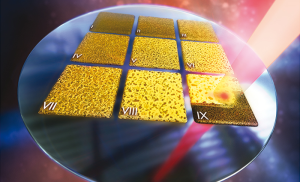
A tunable laser creates a miniature library of nanoporous gold. Image by Ryan Chen/LLNL.
Midas touch on a chip
Lawrence Livermore researchers have created a library of nanoporous gold structures on a single chip that has direct applications for high-capacity lithium ion batteries as well as neural interfaces.
Nanoporous gold (np-Au), a porous metal used in energy and biomedical research, is produced through an alloy corrosion process known as dealloying that generates a characteristic three-dimensional nanoscale network of pores and ligaments.
LLNL researchers and their University of California, Davis collaborators describe a method for creating a library of varying np-Au morphologies on a single chip via precise delivery of tunable laser energy.
“Traditional heat application techniques for the modification of np-Au are bulk processes that cannot be used to generate a library of different pore sizes on a single chip,” said LLNL staff scientist Ibo Matthews. “Laser microprocessing offers an attractive solution to this problem by providing a means to apply energy with high spatial and temporal resolution.”

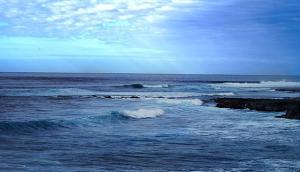
Lawrence Livermore scientists have found the deep ocean in the Southern Hemisphere has absorbed more than half the heat in the past two decades than was absorbed during the entire industrial era.
It’s getting hot in there
The Earth’s oceans are absorbing more heat from a warming world, and the pace of the temperature rise is increasing with each passing decade, researchers have discovered.
In the past two decades alone, the oceans have taken up more than half the increase in heat created by the world’s outpouring of greenhouse gases during the entire industrial era, scientists at Lawrence Livermore said, following a study of ocean temperature records dating back more than a century.
Most of that heat has been absorbed in the upper 2,300 feet of the oceans, but an ever greater amount is reaching into deeper ocean levels — a mile and more down, said Peter Gleckler, a Livermore physicist and climate scientist who led the research.
“The heat capacity of the ocean system is huge,” said Paul Durack, a Livermore oceanographer on the research team. “And that melting land-based ice adds to the total mass of the warming ocean. As the oceans absorb more heat they expand and become a major cause of the sea-level rise we’re already seeing.”

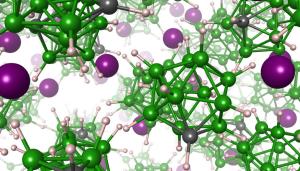
This integrated system would store carbon dioxide in an underground reservoir, with concentric rings of horizontal wells confining the pressurized CO2 beneath the caprock.
Battery power gets out from under the earth
Carbon dioxide goes in. Heat comes out.
That is the basic idea behind the Earth Battery, a novel, grid-scale energy storage concept from Thomas Buscheck and a team of researchers at Lawrence Livermore National Laboratory. Carbon dioxide captured from factories or power plants would be pressurized until it enters a ‘supercritical’ state (something between a liquid and a gas.). It would then get injected into underground wells to a depth of 3,000 to 5,000 feet. The additional pressure caused by CO2 would force hot subterranean brines to the surface: The 120 to 200 degree Celsius fluid could then be retrieved on command for process heat, to balance renewables or run turbines.
If the Earth Battery can get funding, it could inject life into large-scale carbon capture. One of the advantages of the Earth Battery is that it can leverage established equipment and know-how from the geothermal industry.
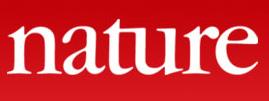
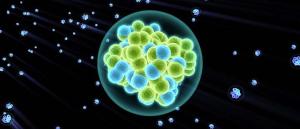
Element 117 is one of the most recent elements to be confirmed by the International Union of Pure and Applied Chemistry. Animation by Kwei-Yu Chu/LLNL
New kids on the block
On New Year ’s Eve, the International Union of Pure and Applied Chemistry (IUPAC) announced the confirmation of the experiments that produced elements 113, 115, 117 and 118, which completes the seventh row of the periodic table. Lawrence Livermore, along with collaborators, received credit for discovery of elements 115, 117 and 118.
The announcement created a great deal of excitement not only in the scientific community, but in the public, and touched off a wave of speculation about what the new elements will be named. IUPAC guidelines authorize the original discoverers to suggest an element name. After the names have been submitted, IUPAC will sanction the names after a period for public comment. The IUPAC guidelines permit an element to be “named after a mythological concept, a mineral, a place or country, a property or a scientist.”
The research groups have been silent on what names might be submitted for IUPAC approval. Proposals for names have come in from a variety of quarters. With all the suggestions and speculation, Nature put together a panel of experts to try and guess what the names might be.

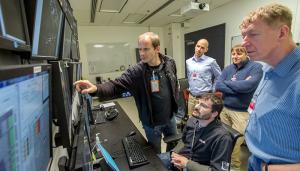
HAPLS team members (from left) Constantin Haefner, Jiri Thoma, James Nissen (sitting), Pavel Bakule and Bedrich Rus review the results of pump laser commissioning tests in the HAPLS control room. Photo by Jason Laurea/LLNL
Czech out this laser
The High-Repetition-Rate Advanced Petawatt Laser System (HAPLS), under construction at Lawrence Livermore has achieved a key average power milestone more than two months ahead of schedule, and is now moving into the next phase in its development.
Completion of this average-power milestone marks another major step in the HAPLS commissioning plan. The beginning of the integration of the pump laser with the HAPLS high-energy short-pulse beamline is destined for the new ELI Beamlines facility in Prague, Czech Republic.
HAPLS is designed to reach a peak power exceeding one petawatt at a repetition rate of 10 times per second to deliver intensities on target up to 1023 watts per square centimeter. Achieving this intensity would open up entirely new areas of laser–matter investigation, enable new applications of laser-driven X-rays and particles, and for the first time, allow researchers to study laser interactions with the sea of virtual particles that comprise a vacuum.





